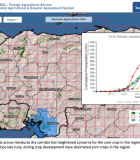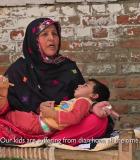USAID Satpara Development Project
The Satpara Development Project is constructing on-farm irrigation systems on 15,500 acres downstream from the Satpara Dam in Gilgit-Baltistan. The project is improving the supply of irrigation water by lining the primary, secondary, and tertiary level water courses; as well as ensuring efficient water use through the introduction of drip and sprinkle irrigation systems. These improvements increase the productivity and availability of the region's high-value fruit, vegetable, and fodder crops. The project is establishing new fruit orchards and fruit nurseries for producing quality fruits in the area. The project introduced passive greenhouse technology in the area. Through this technology, the community is now getting fresh vegetables throughout the winter months, and producers are able to get good profits for their produce.
The Satpara Development Project is also working to develop processing facilities to reduce post-harvest waste, and to train farmers in harvest and post-harvest management techniques including packing, packaging, and marketing. Additionally, the project helps farmers and processors market and sell their products to lucrative national and international markets. To increase milk production, the project works on breed improvement using artificial insemination to introduce higher yielding traits. Policy reform needs are being addressed with provincial government authorities to help create a welcoming business environment.The Satpara Development Project is also working to develop processing facilities to reduce post-harvest waste, and to train farmers in harvest and post-harvest management techniques including packing, packaging, and marketing. Additionally, the project helps farmers and processors market and sell their products to lucrative national and international markets. To increase milk production, the project works on breed improvement using artificial insemination to introduce higher yielding traits. Policy reform needs are being addressed with provincial government authorities to help create a welcoming business environment.
Activity Description
• Construct primary, secondary, and tertiary water courses to improve fodder and agricultural production and improve local roads for better access.
• Establish and train water user associations in irrigation management.
• Introduce improved fruit and vegetable varieties, as well as improved production, management, and handling techniques.
• Create public-private partnerships for agricultural extension and certification services.
• Establish a private-sector processing industry focused on converting fruit waste into additional usable products.
• Introduce improved traits into cattle breeds through artificial insemination.
• Assist the Government of Gilgit-Baltistan in improving the business environment.
• Introduce greenhouse technology for off-season vegetable production.
Expected Outcomes
• Provide irrigation water to 15,500 acres of land
• Increase incomes by 20 percent for 12,000 families
• Create 4,850 new jobs in the region through construction of efficient irrigation systems and improvements in the growing, processing, and marketing of agricultural produce.
Actual Outcomes
• The project has realigned 127 Water User Associations
• Completed 35,469 meters of a planned 34,684 meters of main and secondary channels (98 percent of the LOP target)
• AKRSP reported having formed 44 FEGs; establishing 32 model fruit orchards, 6 nurseries, and 4 certified nurseries; distributing 70,000 certified plants to nurseries; constructing 175 greenhouses; facilitating 28 FFSs in animal husbandry, fodder production and storage, seed production.




